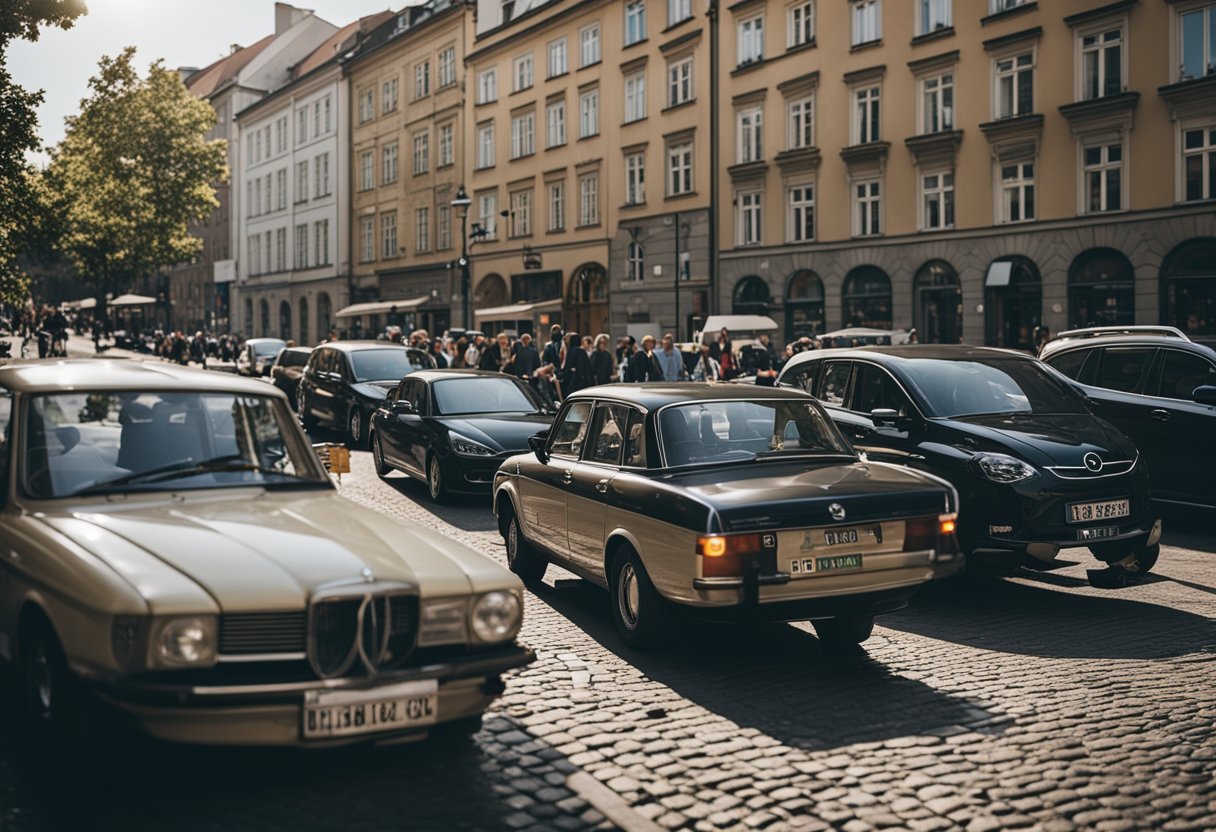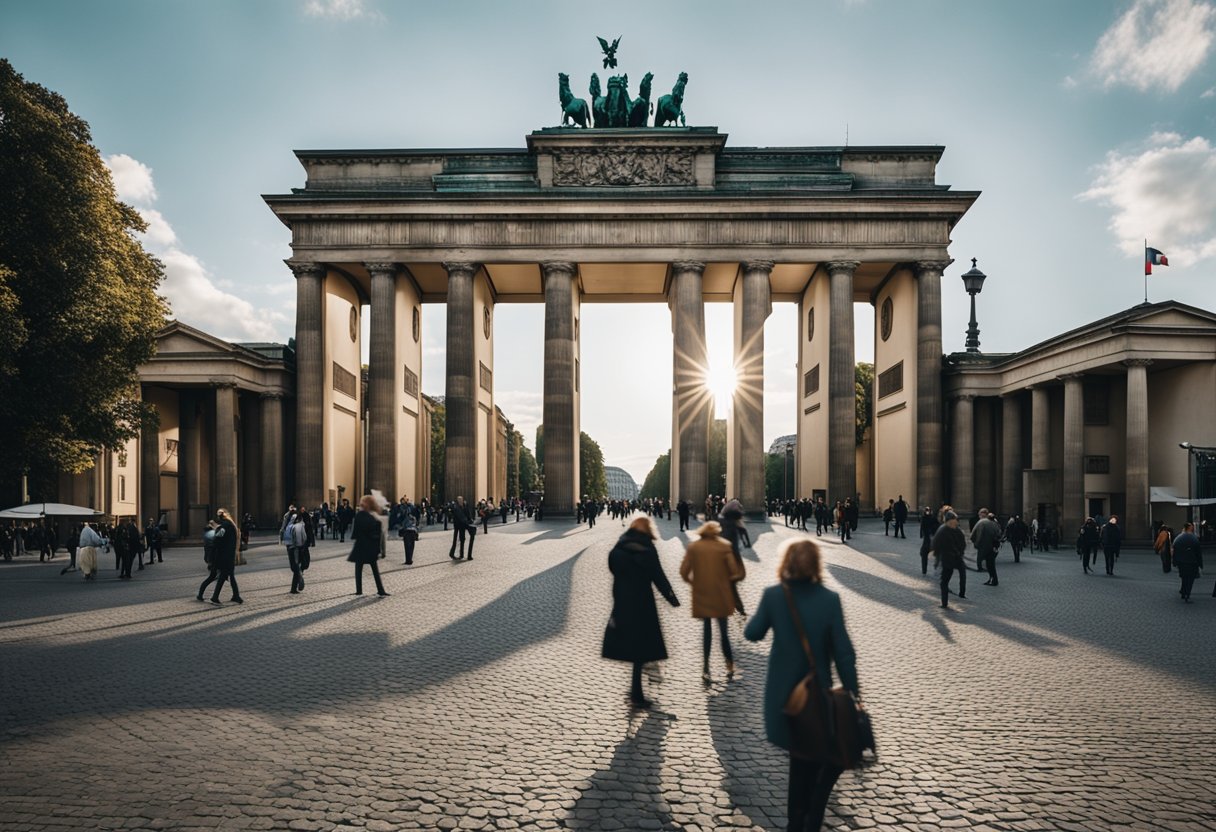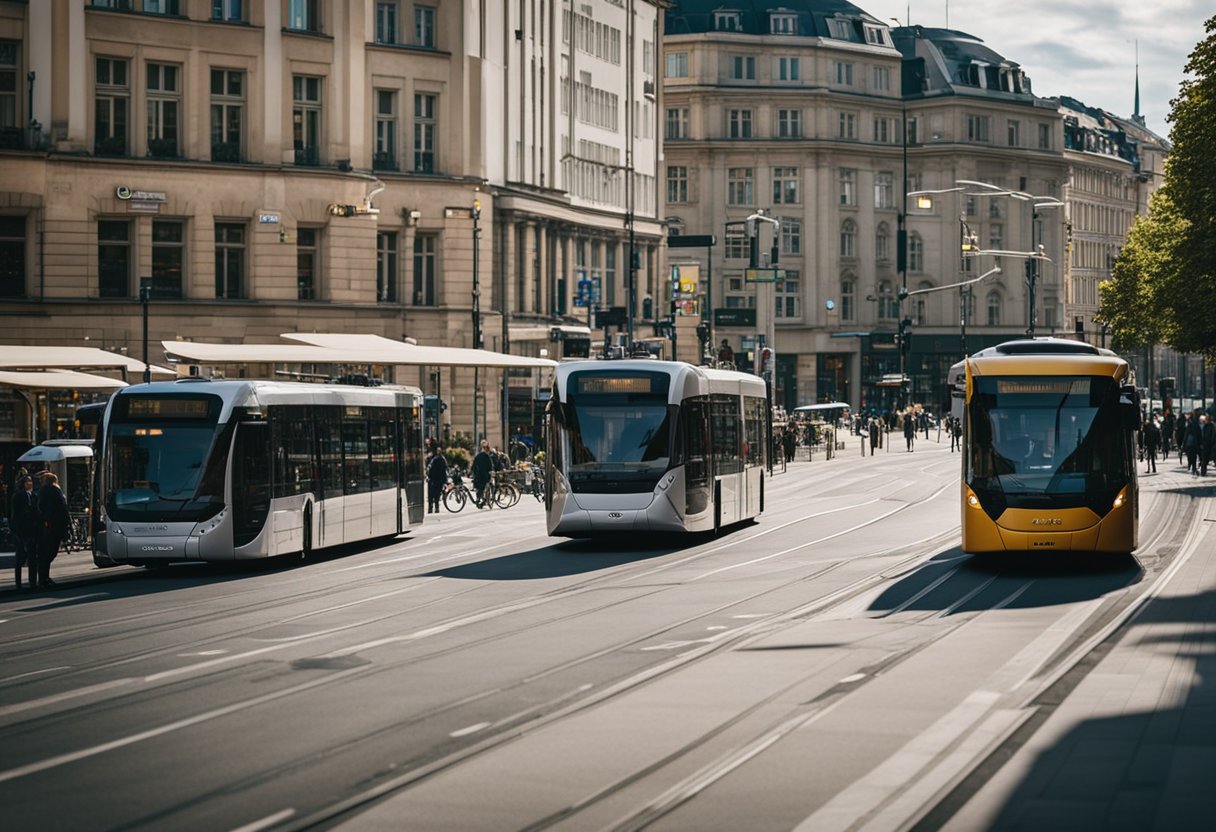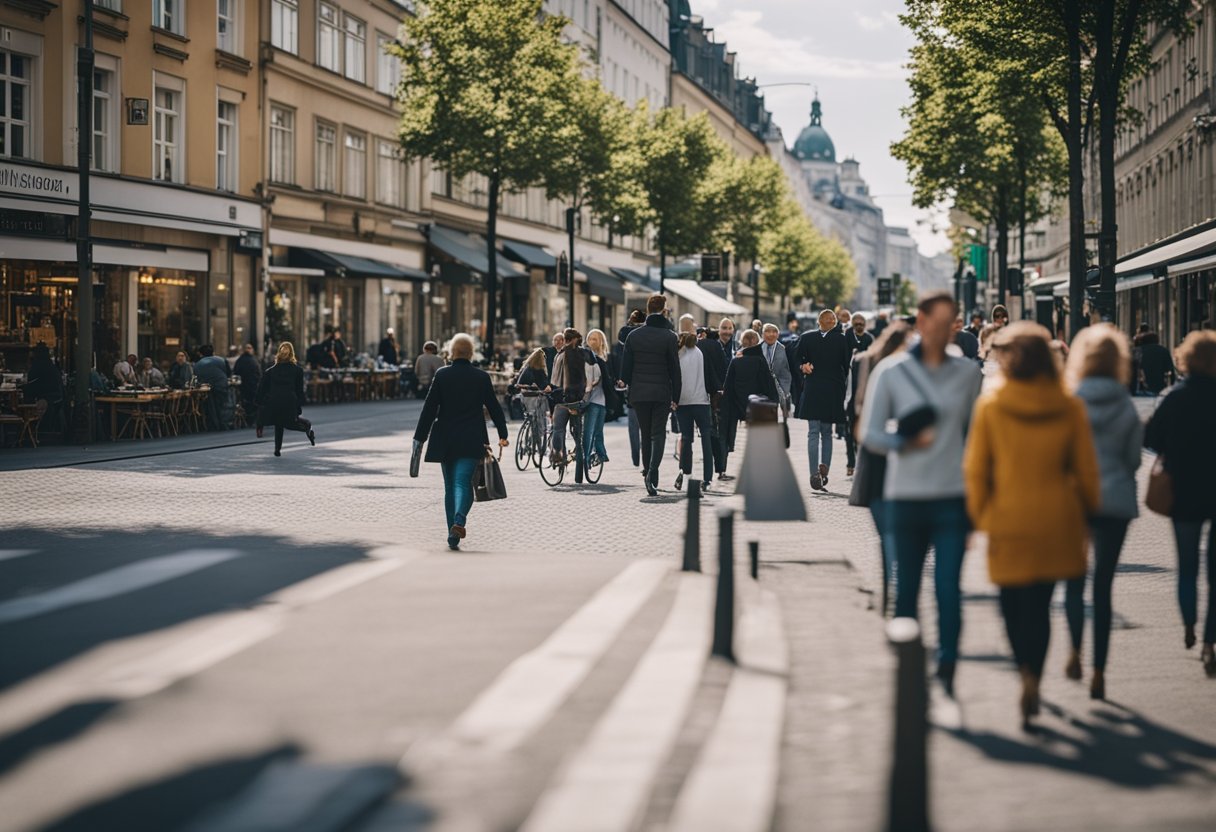Mitte stands as the central borough of Berlin, a place where the past and present of the city converge to tell a story rich with historical landmarks, vibrant cultural scenes, and urban dynamism.
We find ourselves walking the streets that are steeped in history; this is where Berlin was founded in the 13th century and where major events that shaped the city’s and Germany’s destiny have left their indelible mark.

As we explore Mitte, we come to understand why it’s often referred to as the heart of Berlin. It’s not just a geographical center; it’s a snapshot of the city’s soul.
From the iconic Brandenburg Gate to the reflective Memorial to the Murdered Jews of Europe, the narratives of Mitte provide a compelling insight into Berlin’s tumultuous yet fascinating journey through the ages.
Our journey through this borough reveals an area that is both a bustling center of contemporary life and a homage to historical Berlin.
Architectural marvels like the Reichstag and the TV Tower on Alexanderplatz echo the city’s evolving identity. Meanwhile, the array of museums, galleries, and theaters serve as testament to Mitte’s status as a cultural hub, giving us an experience that is as enriching as it is diverse.
History and Culture
In our exploration of Mitte, we uncover a rich tapestry of historical significance and cultural development that has shaped the heart of Berlin. We trace the journey from the district’s origins, through significant upheavals of the 20th century, to its current status as a symbol of reunification and renewal.
Mitte District Origins
Mitte, which translates to “center” in German, serves as the historical nucleus of Berlin. This district was once composed of the twin cities of Alt-Berlin and Cölln which date back to the 13th century. Both cities thrived on commerce, with their location along the Spree River playing a pivotal role in their economic development. The historicity of Mitte is not only confined to buildings and monuments but is also embedded in the cobblestone streets and charming houses reminiscent of its medieval past.
Greater Berlin Act and WWII
Under the Greater Berlin Act of 1920, the city underwent an administrative reorganization which expanded its boundaries and unified several surrounding towns and villages into a single metropolitan area. Mitte thus grew to become the central administrative hub. During World War II, Mitte witnessed severe devastation and loss, bearing the brunt of Allied bombings. Subsequently, it found itself in East Berlin, under the control of the GDR, where it underwent extensive reconstruction in line with socialist urban design.
Reunification and Renewal
The fall of the Berlin Wall in 1989 marked the start of Germany’s reunification and heralded a new era for Mitte. It transformed from a symbol of division into a beacon of cultural confluence and regeneration. We see this in the proliferation of art galleries, museums, and theaters that represent Berlin’s rejuvenated spirit. The World-class museums in Mitte today are a testament to the area’s commitment to honoring its heritage while fostering contemporary culture.
Historical Events
Mitte has borne witness to numerous historical events that have influenced not just Germany, but also the world at large. It is home to iconic landmarks like the Brandenburg Gate and the Reichstag, which symbolize the country’s tumultuous past and its journey towards democracy. The district has also played a central role in commemorating events such as World War II, with memorials that honor the victims and serve as poignant reminders of the impacts of conflict and the value of peace.
Our treatment of Mitte’s history and culture is far from exhaustive but rather a curated look at the profound layers that define its storied existence.
Geography and Urban Structure

In this section, we’ll explore the distinct geographical features and urban structure of Mitte, Berlin’s central borough. We’ll delve into the character of its diverse neighborhoods, including the southeast region around Friedrichstadt and Dorotheenstadt, as well as the northwest areas encompassing Moabit, Wedding, and Gesundbrunnen, all interconnected by the flow of the River Spree.
Neighborhood Overview
Mitte encompasses a diverse range of neighborhoods, each with its own historical and cultural identity. This central borough is the heartbeat of Berlin, where old meets new and the city’s history is most palpable. The River Spree runs through Mitte, providing a natural landmark that has shaped the area’s development.
- Friedrichstadt: Known for its baroque architecture.
- Dorotheenstadt: Home to many governmental buildings.
- Moabit: A melting pot of culture and demographic diversity.
- Wedding: Renowned for its vibrant community life.
- Gesundbrunnen: Offers a mix of green spaces and urban flair.
Southeast Mitte
In the southeast section of Mitte lies Friedrichstadt, an area steeped in history and characterized by baroque architecture. It reflects an era of pomp and grandeur, with wide boulevards and significant buildings such as the Gendarmenmarkt. Close by, Dorotheenstadt is another prominent neighborhood with its stately presence underscored by governmental buildings and embassies.
Northwest Mitte
As we turn our attention northwest, we find Moabit, an island bound by canals and the River Spree, notable for its industrial past and diverse communities. Further north, Wedding and Gesundbrunnen emerge with a predominantly residential fabric. In Wedding, the community’s dynamic social life brings vibrancy to its streets, while Gesundbrunnen presents an urban landscape softened by green spaces like the Volkspark Humboldthain.
Politics and Administration

In our exploration of Berlin Mitte, we find that the area functions within a structured framework of governance that defines its political and administrative landscape.
Borough Governance
Berlin Mitte, governed under the provisions of the Greater Berlin Act, is one of the central boroughs of Berlin. Mitte’s administrative bodies are responsible for the local implementation of legislation and policies. Below, we present the key components of the borough’s administrative structure:
- District Assembly (BVV): Elected representatives draft and pass resolutions on local matters.
- District Mayor: Heads the district office and represents Mitte.
- District Councilors: Oversee various departments like education, finance, and urban development.
- Departments: Execute policies pertaining to their respective fields.
Mayor of Mitte
The office of the Mayor of Mitte holds significant influence in both political strategizing and administrative actions. Current leadership aligns with the borough’s goals for development and public welfare. The mayor’s responsibilities include:
- Representation: Acting as the face of Mitte both within and outside the district.
- Coordination: Ensuring smooth collaborations between the different departments.
- Policy Implementation: Enforcing the laws and policies as determined by the BVV and higher government echelons.
The office of the Mayor, along with the District Assembly, shapes the day-to-day experiences of Mitte’s residents and visitors through their governance.
Tourist Attractions and Landmarks

In Mitte, the historical heart of Berlin, we encounter an impressive array of landmarks that are not only iconic symbols of the city’s history but also hubs of cultural significance.
Brandenburg Gate and Reichstag
The Brandenburg Gate stands as a monumental entry to Unter den Linden, a grand boulevard lined with linden trees. This neoclassical triumphal arch was once a symbol of division but now signifies unity and peace. A short walk away is the Reichstag, home to the German parliament, renowned for its glass dome offering panoramic views of the city.
Checkpoint Charlie and Berlin Wall Memorial
Checkpoint Charlie, the most famous crossing point between East and West Berlin during the Cold War, evokes poignant memories, while the nearby Berlin Wall Memorial offers a powerful testament to the resilience of the human spirit against division and conflict.
Museum Island and Its Museums
Museum Island is a treasure trove of culture, housing five world-renowned museums. Pergamonmuseum boasts an extensive collection of classical antiquities, while the Neues Museum is home to the bust of Nefertiti. The Altes Museum and Alte Nationalgalerie showcase a variety of ancient and 19th-century art respectively.
Berlin Cathedral and Gendarmenmarkt
The magnificent Berlin Cathedral, with its grand dome and ornate interiors, provides a moment of reflection amidst the bustling city. Not far from the cathedral, Gendarmenmarkt stands out as one of the most stunning squares in Berlin, framed by the twin cathedrals and the Konzerthaus theater.
Transportation

In our journey through Mitte, we find ourselves at the heart of Berlin’s extensive transportation network, a hub that simplifies our connectivity within the city and beyond through efficient public transit systems and important thoroughfares.
Public Transit Network
We start by exploring the Public Transit Network, which is the cornerstone of our urban mobility in Mitte. Our options are vast: we can board the U-Bahn (Underground Subway), which operates from early morning hours until past midnight on weekdays, with around-the-clock service on weekends and public holidays. Especially handy is the fact that U-Bahn runs with a frequency of 5 to 10 minutes within the central areas. As night falls, night buses seamlessly take the baton to ensure continuous service.
For surface-level travel, the S-Bahn (Suburban Train) and Trams offer scenic rides through the district. These systems complement each other with multiple lines intersecting at various points, providing us with an intricate network that reaches even the most distant corners of Berlin. Mitte is particularly well-served by these lines, ensuring that we can effortlessly navigate the city.
- Bus Service: Efficient and economical, we find the bus network to be extensive, with routes such as Bus 100 offering scenic journeys past major attractions.
- S-Bahn Lines: Connecting broader cityscapes, it intersects with U-Bahn lines at key junctions like Friedrichstraße.
- U-Bahn Lines: Covering the underground travel, key stations in Mitte include Alexanderplatz and Hauptbahnhof.
- Tram Lines: Trams often complement the U- and S-Bahn by providing service to areas less accessible by rapid transit.
Major Roads and Waterways
Shifting our focus to Major Roads and Waterways, Mitte boasts some of Berlin’s most vital arteries. Streets such as Unter den Linden and Friedrichstraße serve as major veins for both local traffic and visitors, leading us to historic sites and commercial districts. For those preferring the tranquility and perspective of water-based navigation, the Spree River offers alternative routes. Here, water taxis and pleasure cruises present us with leisurely opportunities to absorb the views of Mitte’s skyline, reflecting the harmonious blend of transport modes coexisting in Berlin’s heart.
We embrace our district’s robust transportation infrastructure as a testament to Berlin’s dedication to accessibility and efficiency, ensuring that we can always find our way in and out of Mitte, be it by land or water.
Economy and Retail

In Mitte, we witness a dynamic blend of commerce and consumer culture. Our business district teems with economic activity, while the shopping destinations offer a diverse range of retail experiences.
Business District
Mitte stands as the central business hub of Berlin, boasting an impressive array of corporate offices and commercial enterprises. Notably, Potsdamer Platz and Alexanderplatz are frequented by professionals and visitors alike, establishing themselves as pivotal to our local economy. The district’s economic health is further bolstered by a selection of upscale bars and restaurants, catering to both business clientele and tourists.
Shopping Destinations
Shopping in Mitte provides an expansive retail therapy experience. Our Oranienburger Straße is well-known for its boutique stores and artisanal shops, offering unique finds and exclusive items. On the other hand, Hackescher Markt pulsates with life, hosting vibrant events and an eclectic mix of retail outlets, from trendy fashion stores to traditional arts and crafts. Nearby, several shopping malls amplify our retail offerings, presenting a vast selection for every preference and need. Whether it’s luxury brands or local favorites, our shopping destinations are integral to Mitte’s character.
For those exploring our locale, the range of options here sets the stage for a full day of engaging retail experiences and discoveries.
Arts and Entertainment
In Mitte, arts and culture pulsate through the streets day and night, offering an unrivaled combination of high-caliber museums and a vibrant nightlife scene. We’ll guide you through some of the most notable cultural institutes and leisure activities that define the heart of Berlin.
Cultural Institutes
Mitte is the core of Berlin’s art scene, home to a plethora of impressive museums. The area boasts historical treasures such as the Altes Museum, showcasing classical antiquities, and the cutting-edge Hamburger Bahnhof, dedicated to contemporary art. Furthermore, an array of galleries amplify the artistic vibe, with EIGEN+ART setting the standard for avant-garde and emerging art. Mitte is also a fashion hotspot where designer boutiques and high-street fashion converge, reflecting the district’s unique sartorial elegance.
- Museums: Altes Museum, Hamburger Bahnhof
- Galleries: EIGEN+ART
Nightlife and Leisure
As dusk falls, Mitte transforms into a hive of nightlife. Our district’s clubs range from the legendary techno hub Berghain to more intimate venues playing eclectic sounds. Leisure options abound; one can enjoy an equally lively scene at local cafés and bars that spill onto the pavements, offering perfect vantage points for people watching. Events and exhibitions frequently shake up the cultural calendar, ensuring that the heart of Berlin never skips a beat.
- Clubs: Berghain
- Cafés: Local favorites with outdoor seating
Mitte’s art and entertainment are as dynamic and diverse as the city itself. With a rich tapestry of cultural offerings and nocturnal delights, our district encourages exploration and engagement at every corner.
Educational and Scientific Institutions
In the heart of Berlin, Mitte is a central hub for various educational and scientific establishments that contribute to the area’s rich academic and cultural landscape. We’ll explore some of the key institutions that embody the district’s intellectual spirit.
Humboldt Forum
The Humboldt Forum represents an expansive venue that has assumed a significant role in Berlin’s cultural scene. Anchored in the reconstructed Berlin Palace, it houses exhibits and activities that encompass art and culture. This includes elements from the ethnological collections of the Staatliche Museen zu Berlin and the extensive holdings of the Berlin State Library. The Forum acts as a space for scholarly exchange and public engagement, where the interplay of art and science flourishes.
University Facilities
Mitte is proud to host several prestigious university facilities, including the world-renowned Humboldt University of Berlin. A bastion of knowledge, Humboldt University provides comprehensive academic programs across various disciplines such as mathematics, computer science, humanities, and social sciences. Its central location in Mitte places it at the crossroads of historical prestige and contemporary research.
In our exploration of Mitte, it’s evident that the district’s educational and scientific institutions are instrumental in shaping a dynamic community that values knowledge, culture, and history. These establishments, from the Humboldt Forum to the academic halls of Humboldt University, offer a testament to Berlin’s steadfast commitment to education and scientific inquiry.
International Relations
In our engagement with the global community, Mitte actively fosters strong international relationships through both formalized sister city partnerships and extensive cultural exchange programs.
Sister Cities
We are proud to have established a sister city relationship with a number of international cities that enhances our political, economic, and cultural ties. Hanoi, Vietnam, for example, stands out as a significant sister city. This relationship allows us to encourage mutual understanding and share best practices in urban development and sustainability.
Cultural Exchange
Cultural exchange is another area where we thrive, hosting art exhibits, musical performances, and educational programs with our international partners. Our bond with Vietnam is particularly strong in this regard, opening avenues for exchange that enrich both Mitte and our Vietnamese counterparts on countless levels.
Through initiatives such as artist-in-residence programs, we invite international creatives to experience life in Mitte and in turn, send our local artists abroad to gain new insights and inspirations. The cross-pollination of culture is essential in fostering a vibrant, dynamic community that benefits all.
Contemporary Mitte
In recent years, Mitte has undergone a significant transformation, reshaping its urban landscape and community dynamics while upgrading its infrastructure to become a nexus of modern living in Berlin.
Urban Development
Mitte has experienced vigorous urban development, particularly in areas such as Spandauer Vorstadt and Rosenthaler Vorstadt. The district’s strategy focuses on balancing historical preservation with the construction of modern commercial and residential buildings. For instance, Friedrichshain has seen the rise of innovative architectural projects that harmonize with the historical character evident in districts like Kreuzberg.
- Prenzlauer Berg has been refurbished to include contemporary housing facilities while retaining its classic charm.
- In Scheunenviertel, there is a trend of converting older buildings into fashionable lofts and galleries, signifying a blend of the old and new.
Community and Living
In Mitte, the essence of community and living is articulated through a multicultural tapestry and elevated quality of life. Spots like Prenzlauer Berg have evolved into family-friendly neighborhoods, boasting a plethora of parks, cafes, and boutiques.
- Young professionals and creatives are drawn to Rosenthaler Vorstadt for its vibrant street life and cultural offerings.
- Scheunenviertel remains a melting pot, akin to its early days as a settlement, reflecting diverse backgrounds and fostering a rich, integrative community.
Infrastructure
Our district’s infrastructure is robust, underpinning the area’s rapid growth and high standards of living. With advancements in public transportation and services, we’ve ensured that Mitte remains well-connected and accessible.
- The availability of high-speed internet and the presence of startup hubs have made Mitte a desirable area for entrepreneurs, especially in Friedrichshain.
- Green spaces are meticulously maintained, and initiatives are in place to incorporate environmental sustainability into urban planning.
While Mitte does not boast traditional beaches, the urban landscape offers a variety of leisure activities that utilize natural and manmade spaces creatively to provide relaxation and recreation opportunities.
Guides and Recommendations
In our guidance, we focus on the essential information for visitors and residents to navigate the core attractions and sights of Mitte with confidence. From Karl-Marx-Allee’s historical grandeur to the resilience symbolized by Rotes Rathaus, we compile tips that are both insightful and practical.
Visitor Information
Mitte, embodying the historical and cultural heartbeat of Berlin, is a treasure trove of must-see attractions and sights. To make the most of your visit:
- Top Attractions: Must-visit spots include Museum Island for art aficionados, the Reichstag for history buffs, and the iconic TV Tower for panoramic city views.
- Things to Do: Explore a converted WWII bunker housing the private Boros Collection, or stroll along the stately Karl-Marx-Allee. Don’t miss the legendary bust of Nefertiti in the Neues Museum.
Visitors are encouraged to check out Culture Trip’s guide to Mitte, which provides a curated selection of activities and experiences.
Resident Tips
For residents, Mitte offers much more than tourist spots; it’s a vibrant district full of hidden gems and local favorites. Consider these:
- Dining: Find the best local cuisine by exploring recommendations from Berlin’s top food spots in Mitte.
- Local Culture: Engage with the community by participating in events near Rotes Rathaus and enjoying the architectural marvels along Karl-Marx-Allee.
Our advice is tailored to enhance your understanding and enjoyment of Mitte, whether you’re piecing together your itinerary or seeking a deeper connection with your neighborhood.